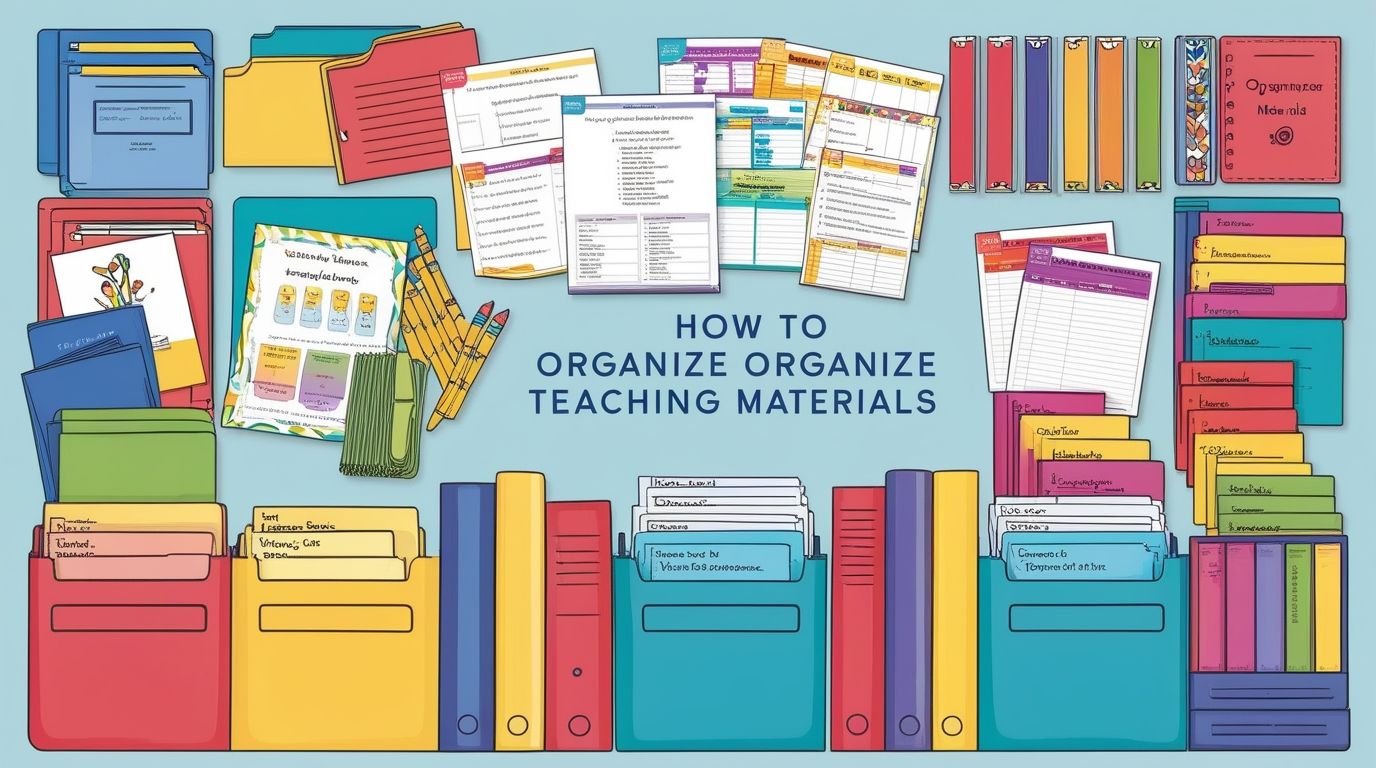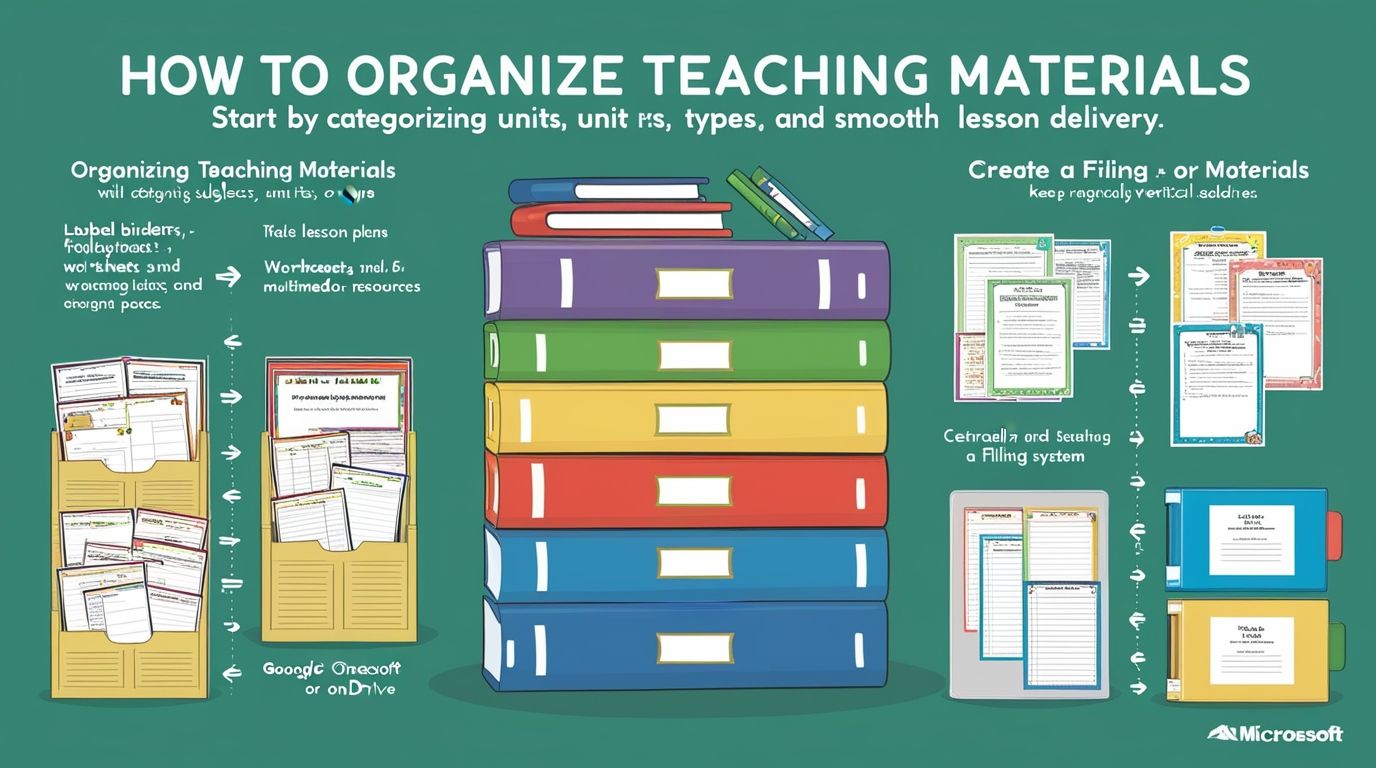Introduction
How to Organize Teaching Materials, Effective organization of teaching materials is essential for educators to facilitate a smooth and engaging learning experience. Proper organization helps teachers manage their resources efficiently, reduce preparation time, and create a more structured and productive learning environment for students. This article outlines strategies for organizing teaching materials, including digital tools, physical storage solutions, and time management techniques that can help educators stay organized throughout the academic year.
1. Categorizing Teaching Materials
The first step in organizing teaching materials is to categorize them based on their type and use. Categories may include lesson plans, worksheets, assessments, multimedia resources, student work, and reference materials. By grouping items into specific categories, teachers can quickly locate the materials they need for each lesson, saving valuable time.
To further refine this system, materials can be organized by subject, grade level, or unit. For example, a math teacher might separate materials into units such as algebra, geometry, and statistics, while an elementary school teacher might categorize by subjects like math, science, and reading. Using clearly labeled folders, binders, or digital files for each category ensures that resources are easy to find and access when needed.
Color-coding is another effective method for categorization. Assigning different colors to each category or subject can provide a visual cue that simplifies navigation through materials. For instance, all math-related items might be in green folders, while science materials are in blue. This system can be applied both to physical and digital storage solutions.
2. Utilizing Digital Tools and Technology
Incorporating digital tools and technology into the organization of teaching materials can significantly enhance efficiency and accessibility. Cloud-based storage solutions like Google Drive, Dropbox, and Microsoft OneDrive allow teachers to store, organize, and share materials easily. These platforms offer the advantage of accessing resources from any device with internet connectivity, making it convenient for lesson planning both at school and at home.
Digital organization tools such as Evernote, Trello, or Microsoft OneNote can help teachers keep track of lesson plans, to-do lists, and ideas in a centralized location. These tools allow for the creation of digital notebooks or boards where educators can store links, images, documents, and notes, all organized by subject or topic.
Learning management systems (LMS) such as Google Classroom, Moodle, or Canvas provide additional organizational features specifically designed for education. These platforms allow teachers to create courses, distribute assignments, communicate with students, and track progress—all within a structured, digital environment. Using an LMS helps ensure that teaching materials are not only well-organized but also easily accessible to students, enhancing the overall learning experience.
3. Developing a Filing System for Physical Materials
For physical teaching materials, an effective filing system is essential. This could include filing cabinets, shelves, binders, or portable storage solutions such as file boxes or carts. Materials should be filed in a logical and consistent manner, such as alphabetically, by subject, or by date.
Binders are a popular choice for organizing lesson plans, worksheets, and handouts. They can be divided into sections using tab dividers, with each section representing a different unit, subject, or type of resource. Sheet protectors can be used to keep materials in good condition, and binders can be stored on shelves labeled according to their contents.
For smaller items such as flashcards, manipulatives, or small activity kits, using labeled plastic containers or drawers can help keep everything in order. Clear containers are particularly useful as they allow teachers to see the contents at a glance. Labeling each container with the type of material or specific use can further enhance this system.
To prevent clutter, teachers should regularly review their physical materials and remove or archive outdated or unused items. A periodic decluttering session can keep storage spaces tidy and ensure that only relevant materials are readily available.

4. Creating a Centralized Resource Hub
A centralized resource hub can serve as a one-stop location for all teaching materials. This hub could be a dedicated space in the classroom, a digital repository, or a combination of both. The key is to have a consistent and accessible place where all resources are stored and easily retrievable.
In the classroom, a centralized hub might include a well-organized bookshelf, a cart with labeled drawers, or a filing cabinet with clearly marked folders. Digital hubs, on the other hand, can be created using cloud storage or an LMS, where files are organized into folders or sections that mirror the physical setup.
Consistency in organizing both physical and digital hubs helps streamline the retrieval process. For example, a math unit on fractions might be found in the same section of the binder as it is in the digital folder. This dual-system approach ensures that regardless of format, materials are easy to find and use.
5. Implementing a Routine for Organization
Maintaining an organized system requires routine upkeep. Teachers should set aside regular time, such as once a week or at the end of each month, to review and organize their materials. During this time, new resources can be filed appropriately, outdated items can be archived or discarded, and any necessary adjustments to the organization system can be made.
Creating checklists or a set of organizational guidelines can help keep the process consistent. For example, teachers might develop a checklist for the end of each week that includes filing new materials, clearing off desks, and updating digital files. By incorporating these tasks into their regular routine, teachers can prevent disorganization from accumulating and ensure that their materials remain easily accessible.
Additionally, involving students in the organization process can foster a sense of responsibility and community within the classroom. Assigning roles such as classroom librarian or materials manager can help keep shared resources tidy and organized, while also teaching students valuable organizational skills.
6. Maximizing Classroom Space
Classroom space can often be limited, so making the most of available space is crucial for keeping teaching materials organized. Vertical storage solutions, such as wall-mounted shelves, pegboards, or hanging file organizers, can free up floor space and keep materials within easy reach.
Using multi-functional furniture, such as desks with built-in storage or rolling carts that can be moved as needed, can also help maximize space. For classrooms with limited storage, collapsible or stackable storage options provide flexibility and can be tucked away when not in use.
Labeling is key in a space-efficient classroom. Clearly labeled shelves, bins, and drawers ensure that materials are returned to their proper place, reducing clutter and saving time when searching for resources. Visual labels, such as pictures or icons, can be especially helpful in younger classrooms where students are still learning to read.

7. Staying Adaptable and Open to Change
Teaching is a dynamic profession, and the needs of educators and students can change over time. Therefore, it’s important for teachers to remain adaptable and willing to modify their organizational systems as needed. This might involve updating digital tools, reconfiguring physical storage, or adjusting categories to better fit new curricula or teaching styles.
Seeking feedback from colleagues and staying informed about new organizational tools and strategies can also help teachers refine their systems. Professional development workshops, online forums, and educator networks are great resources for discovering new ideas and solutions that can be tailored to individual needs.
Flexibility in organization ensures that teaching materials remain relevant and accessible, supporting educators in their goal of providing effective and engaging instruction.
Conclusion
Organizing teaching materials is a vital aspect of classroom management that contributes to a more effective and enjoyable teaching and learning experience. By categorizing materials, utilizing digital tools, developing a robust filing system, creating a centralized resource hub, implementing organizational routines, maximizing classroom space, and staying adaptable, teachers can maintain a well-organized environment that supports their instructional goals. An organized system not only saves time and reduces stress but also fosters a more structured and productive learning atmosphere for students.
References
- Hyun, J. (2017). A Study on the Organization and Management of Teaching Materials in Secondary Schools. Journal of Educational Research and Practice, 7(2), 105-117.
- Lamb, A., & Johnson, L. (2019). Organizing Digital Resources: Strategies for K-12 Teachers. TechTrends, 63(3), 314-321.
- Van Eck, R., & Hung, W. (2018). Digital Storage and Retrieval: The New Literacy for Teachers. Educational Technology, 58(4), 24-31.
- Whittemore, S. (2020). Classroom Organization and Efficiency: Tips for Teachers. The Journal of Classroom Management, 12(1), 78-89.
- Wong, H. K., & Wong, R. T. (2018). The Classroom Management Book. Harry K. Wong Publications, Inc.
- Zadina, J. N. (2021). Multiple Pathways to the Student Brain: Energizing and Enhancing Instruction. Jossey-Bass.

4 thoughts on “How to Organize Teaching Materials”
Comments are closed.